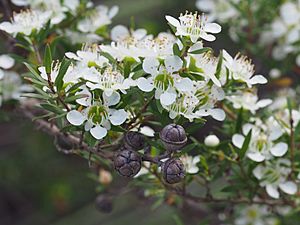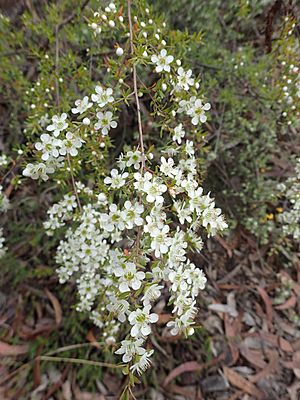Tantoon facts for kids
Quick facts for kids Tantoon |
|
|---|---|
 |
|
| In Sherwood Nature Reserve | |
| Scientific classification |
|
| Kingdom: | Plantae |
| Clade: | Tracheophytes |
| Clade: | Angiosperms |
| Clade: | Eudicots |
| Clade: | Rosids |
| Order: | Myrtales |
| Family: | Myrtaceae |
| Genus: | Leptospermum |
| Species: | |
| Subspecies: |
L. p. subsp. cismontanum
|
| Trinomial name | |
| Leptospermum polygalifolium subsp. cismontanum Joy Thomps.
|
|
| Synonyms | |
|
|
Leptospermum polygalifolium subsp. cismontanum, commonly known as tantoon, is a subspecies of flowering plant in the family Myrtaceae and is endemic to near-coastal areas of eastern Australia. It is a shrub or small tree with elliptical leaves and white flowers in spring.
Description
Leptospermum polygalifolium subsp. cismontanum is a shrub that typically grows to a height of 1 m (3 ft 3 in), sometimes a slender tree to 4 m (13 ft). Its leaves are elliptical, sometimes broader in the upper part, dull green but paler on the lower surface, usually 8–10 mm (0.31–0.39 in) long and 2 mm (0.079 in) wide with the edges tending to turn downwards. The flowers are white, about 10 mm (0.39 in) in diameter with a hypanthium 2.5–3 mm (0.098–0.118 in) long. The sepals are 1.5–2 mm (0.059–0.079 in) long with pale, thin edges. Flowering occurs in September and October and the fruit is a capsule 5–7 mm (0.20–0.28 in) in diameter.
Taxonomy
This subspecies was first described in 1989 by Joy Thompson in the journal Telopea, from specimens collected near Dungog in 1975.
Distribution and habitat
Leptospermum polygalifolium subsp. cismontanum is common in near-coastal forests between Fraser Island in Queensland and Gosford in New South Wales. It often grows on sandstone but is also found in coastal swamps, old dunes and hillsides.


